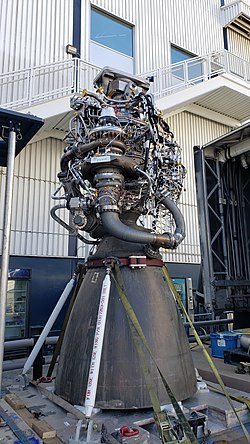 A Raptor 1 rocket engine ready for transport outside SpaceX's factory in Hawthorne, California | |
| Country of origin | United States |
|---|---|
| Manufacturer | SpaceX |
| Associated LV | SpaceX Starship |
| Status | In production |
| Liquid-fuel engine | |
| Propellant | LOX / CH4 |
| Mixture ratio | 3.6 (78% O2, 22% CH4)[1][2] |
| Cycle | Full-flow staged combustion |
| Pumps | 2 turbopumps |
| Configuration | |
| Chamber | 1 |
| Nozzle ratio | |
| Performance | |
| Thrust | Raptor 1: 185 tf (1.81 MN; 408,000 lbf)[5] Raptor 2: Raptor 3: 280 tf (2.75 MN; 617,000 lbf) |
| Throttle range | 40–100%[10] |
| Thrust-to-weight ratio | Raptor 1: 88.94
Raptor 2: 141.1 Raptor 3: 183.6 |
| Chamber pressure |
|
| Specific impulse, vacuum | 380 s (3.7 km/s)[8] |
| Specific impulse, sea-level | 327 s (3.21 km/s)[9] |
| Mass flow | |
| Burn time | Varies |
| Dimensions | |
| Length | 3.1 m (10 ft)[13] |
| Diameter | 1.3 m (4 ft 3 in)[14] |
| Dry mass | Raptor 1: 2,080 kg (4,590 lb)
Raptor 2: 1,630 kg (3,590 lb) Raptor 3: 1,525 kg (3,362 lb) |
Raptor is a family of rocket engines developed and manufactured by SpaceX. It is the third rocket engine in history designed with a full-flow staged combustion (FFSC) fuel cycle, and the first such engine to power a vehicle in flight.[15] The engine is powered by cryogenic liquid methane and liquid oxygen, a mixture known as methalox.
SpaceX's super-heavy-lift Starship uses Raptor engines in its Super Heavy booster and in the Starship second stage.[16] Starship missions include lifting payloads to Earth orbit and is also planned for missions to the Moon and Mars.[17] The engines are being designed for reuse with little maintenance.[18]
- ^ Sierra Engineering & Software, Inc. (18 June 2019). "Exhaust Plume Calculations for SpaceX Raptor Booster Engine" (PDF). p. 1. Archived (PDF) from the original on 20 October 2021. Retrieved 17 September 2021.
The nominal operating condition for the Raptor engine is an injector face stagnation pressure (Pc) of 3669.5 psia and a somewhat fuel-rich engine O/F mixture ratio (MR) of 3.60. The current analysis was performed for the 100% nominal engine operating pressure (Pc=3669.5 psia) and an engine MR of 3.60.
- ^ Space Exploration Technologies Corp. (17 September 2021). "Draft Programmatic Environmental Assessment for the SpaceX Starship/Super Heavy Launch Vehicle Program at the SpaceX Boca Chica Launch Site in Cameron County, Texas" (PDF). faa.gov. FAA Office of Commercial Space Transportation. p. 12. Archived (PDF) from the original on 17 September 2021. Retrieved 17 September 2021.
Super Heavy is expected to be equipped with up to 37 Raptor engines, and Starship will employ up to six Raptor engines. The Raptor engine is powered by liquid oxygen (LOX) and liquid methane (LCH4) in a 3.6:1 mass ratio, respectively.
- ^ Sierra Engineering & Software, Inc. (18 June 2019). "Exhaust Plume Calculations for SpaceX Raptor Booster Engine" (PDF). p. 1. Archived (PDF) from the original on 20 October 2021. Retrieved 17 September 2021.
The subject engine uses a closed power cycle with a 34.34:1 regeneratively-cooled thrust chamber nozzle.
- ^ Dodd, Tim (7 August 2021). ""Starbase Tour with Elon Musk [PART 2]"". Everyday Astronaut. 4 minutes in. Youtube. Archived from the original on 17 February 2024. Retrieved 23 February 2024.
- ^ Bergin, Chris (23 January 2022). "Raptor 2 testing at full throttle on the SpaceX McGregor test stands". NASASpaceFlight.com. Retrieved 22 March 2022.
- ^ Dodd, Tim (14 July 2022). "Raptor 1 VS Raptor 2: What's New // What's Different". Everyday Astronaut. Youtube. Archived from the original on 15 July 2022. Retrieved 15 July 2022.
- ^ "Starship : Official SpaceX Starship Page". SpaceX. Archived from the original on 22 May 2020. Retrieved 24 May 2020.
- ^ Musk, Elon [@elonmusk] (9 September 2019). "Sea level Raptor's vacuum Isp is ~350 sec, but ~380 sec with larger vacuum-optimized nozzle" (Tweet). Archived from the original on 25 September 2019 – via Twitter.
- ^ Cite error: The named reference
SpaceX20180917was invoked but never defined (see the help page). - ^ Musk, Elon [@elonmusk] (18 August 2020). "Max demonstrated Raptor thrust is ~225 tons & min is ~90 tons, so they're actually quite similar. Both Merlin & Raptor could throttle way lower with added design complexity" (Tweet) – via Twitter.
- ^ At 2.23 MN thrust and 350 s specific impulse
- ^ a b 78% O2, 22% CH4 mixture ratio
- ^ "Starship | SpaceX". Archived from the original on 30 September 2019. Retrieved 2 October 2019.
- ^ Cite error: The named reference
youtube-makinglifemultiwas invoked but never defined (see the help page). - ^ Dodd, Tim (25 May 2019). "Is SpaceX's Raptor engine the king of rocket engines?". Everyday Astronaut. Youtube. Archived from the original on 22 May 2023. Retrieved 22 May 2023.
- ^ "Starship Users Guide, Revision 1.0, March 2020" (PDF). SpaceX/files. SpaceX. March 2020. Archived from the original (PDF) on 2 April 2020. Retrieved 18 May 2020.
SpaceX's Starship system represents a fully reusable transportation system designed to service Earth orbit needs as well as missions to the Moon and Mars. This two-stage vehicle — composed of the Super Heavy rocket (booster) and Starship (spacecraft)
- ^ Leone, Dan (25 October 2013). "SpaceX Could Begin Testing Methane-fueled Engine at Stennis Next Year". Space News. Archived from the original on 25 October 2013. Retrieved 26 October 2013.
- ^ Neff, William; Steckelberg, Aaron; Davenport, Christian (9 January 2023). "The rockets NASA and SpaceX plan to send to the moon". The Washington Post. Archived from the original on 17 April 2023. Retrieved 28 August 2023.